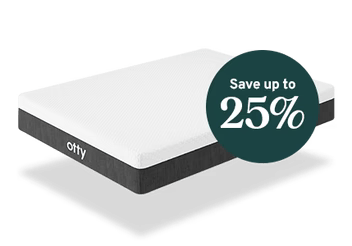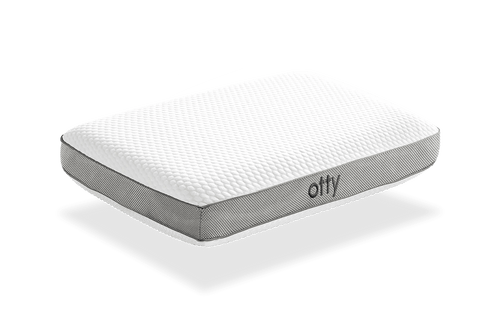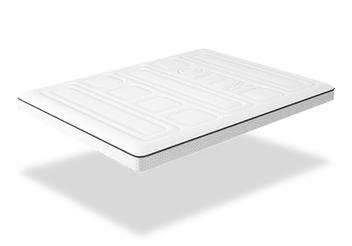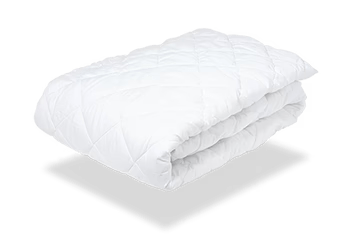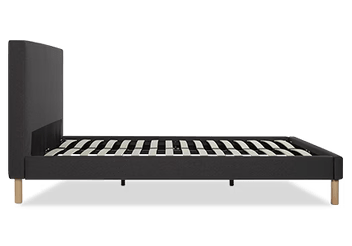Memory foam mattresses are one of the most popular types of mattress on the market - but what are they, and what makes them so popular?
In this guide we'll tell you all you need to know about memory foam, from its innovative origins in NASA to its evolution into a popular mattress material.
If you're considering buying a memory foam mattress, you can also read about all of the advantages and disadvantages.
Table of contents
What Is A Memory Foam Mattress?
A memory foam mattress is a type of mattress made from viscoelastic polyurethane foam, designed to conform to the shape of your body in response to heat and pressure.
This allows it to provide personalised support, reduce pressure points, and improve spinal alignment. Memory foam mattresses are known for their ability to absorb movement, making them a popular choice for couples, as one person's movement is less likely to disturb the other.
How Does Memory Foam Work?
Memory foam, a type of visco-elastic material, is a product of polyurethane, a common polymer, combined with various compounds and additives. These additives are what give memory foam its unique properties, such as viscosity and elasticity.
Viscosity in memory foam refers to its slow response to pressure, allowing it to gradually change shape and mould to your body contours. This slow response is what makes memory foam an excellent shock absorber, as it can effectively distribute the force of an impact.
On the other hand, the elasticity of memory foam gives it the ability to return to its original shape once the pressure is removed. This is why memory foam mattresses can retain their shape for years, despite being subjected to nightly pressure from sleepers.
How A Memory Foam Mattress Moulds To Your Body Shape
Memory foam mattresses mould to the body's shape, providing personalised comfort and support. This characteristic is largely due to the role of body heat in the functioning of memory foam.
When you lie on a memory foam mattress, the foam absorbs your body heat. This heat softens the foam, allowing it to change shape and contour to your body's unique curves. This is a key feature of memory foam support layers, providing a level of firmness that adjusts to your body's needs.
However, this heat absorption can also lead to the mattress retaining heat, making it feel warmer the longer you lay on it. This is a common concern with older types of memory foam, which were less breathable and more prone to heat retention.
Modern memory foam products have evolved to address this issue. They are designed to be more breathable, reducing the amount of heat they retain. Some even integrate cooling technologies, such as gel beads or ventilated structures, to further dissipate heat and maintain a comfortable sleeping temperature.
Memory foam absorbs body heat, which softens the foam
The foam can then contour to your body's profile
Breathable qualities ensure body heat is not retained
Different Types of Memory Foam Mattresses
Traditional Memory Foam
This is the original, classic type of memory foam. It's engineered to mould to your body, providing a personalised sleep surface. However, it tends to retain heat, which can make the mattress uncomfortably warm.
Open-Cell Memory Foam
This type has the same ingredients as traditional memory foam but with a different internal structure. It features internal pockets or "open cells" that allow for ventilation and air flow throughout the mattress, helping to disperse heat.
Gel Memory Foam
This type incorporates gel in its construction. Gel-based microbeads are pumped into the foam, creating pockets similar to those in open-cell mattresses. These gels actively absorb and release heat from your body, providing a cooler sleep surface.
Copper-Infused Memory Foam
Some memory foam mattresses incorporate copper in their construction. Copper is highly conductive and helps with both heat-dispersal and moisture-wicking, enhancing the comfort of the mattress.
Eco-Friendly Memory Foam
This is an up-and-coming innovation in memory foam technology. These foams are designed to be more environmentally friendly, reducing the environmental impact of your mattress.
Qualities of Memory Foam
Memory foam has a unique ability to mould to the contours of your body
It absorbs both pressure and heat, which allows it to change shape and provide unparalleled support and comfort
As the temperature of the sleep surface increases, the foam becomes less stiff and more flexible. This is why memory foam mattresses often feel softer or more pliable after you've been lying on them for a while.
Despite its ability to mould to your body shape, it can return to its original shape once the pressure is removed. This recovery period, which typically lasts around 5-10 seconds, is crucial in absorbing and dissipating the energy from the impact of your body.
Memory foam's density reduces motion transfer, making it an excellent choice for co-sleepers and couples.
This density also contributes to its allergen-resistant properties, as it is less likely to attract and accumulate common irritants such as dust mites and mould
Innovations in Memory Foam Technology
Memory foam technology has come a long way since its inception.
The original memory foam, while revolutionary, had its drawbacks, particularly in terms of heat retention. This led to the development of open-cell and gel memory foam, both designed to address this issue.
Open-cell memory foam, with its unique internal structure, allows for better ventilation and air flow. This helps to keep the sleep surface cool, enhancing the comfort of the mattress.
Gel memory foam, on the other hand, incorporates gel-based microbeads into the foam. These microbeads actively absorb and release body heat, further improving the cooling effect.
In recent years, we've seen the introduction of other materials into memory foam mattresses. Copper, for instance, is now being used due to its high conductivity. It aids in heat-dispersal and moisture-wicking, making the mattress even more comfortable.
Another significant innovation in memory foam technology is the development of eco-friendly foams. These are designed to be more sustainable and less harmful to the environment, without compromising on the comfort and support that memory foam is known for.
These advancements in memory foam technology have not only improved the quality and comfort of mattresses but have also made them more accessible and appealing to a wider range of consumers.
Some memory foam mattresses tend to trap heat, which can be uncomfortable for hot sleepers. Look for cool memory foam options if heat retention is a concern for you.
The Advantages of Memory Foam Mattresses
Pressure Relief
Memory foam mattresses are known for their ability to contour to the body, providing relief in areas we put the most pressure on during sleep, such as the hips, shoulders, and neck. This can reduce pain and discomfort, especially for those with joint pain or arthritis.
Spinal Alignment
The contouring qualities of memory foam can promote good spinal alignment and provide lumbar support. This can prevent tossing and turning at night, as well as back pain and soreness in the morning.
Allergen Resistant
Due to their dense structure, memory foam mattresses are less likely to attract and accumulate allergens, such as dust mites, mold, and other common irritants. This makes them a great choice for people with allergies.
Reduces Motion Transfer
Memory foam mattresses are excellent at reducing motion transfer. This is particularly beneficial for co-sleepers and couples, especially those who are light sleepers. The density of memory foam and the way it distributes pressure ensures that movement on one part of the bed is not felt on another part.
Quiet
Unlike some other types of mattresses, memory foam mattresses are generally very quiet, which can contribute to a peaceful night's sleep.
Potential Disadvantages of Memory Foam Mattresses
Heat Retention
Memory foam mattresses are known to trap heat due to their design and material density. This can lead to discomfort, especially for those who are naturally hot sleepers.
Cost
Memory foam mattresses tend to be pricier than other types. Even though the cost has decreased with their growing popularity, they are still generally a costlier option.
Not Waterproof
Memory foam mattresses can be damaged by water and other liquids, which can degrade the foam and reduce its lifespan. This is particularly inconvenient for those living in high-humidity areas or households with young children or pets.
"Stuck" Feeling
Some people find that memory foam mattresses can make them feel too sunk into the material, making it difficult to move during the night. This feeling can increase as the mattress ages.
Off-Gassing and Odours
New memory foam mattresses often have a distinct, chemical-like smell, referred to as "off-gassing". This can be off-putting for some people, although the smell usually dissipates over time.
Potential Allergies
Although rare, it is possible to be allergic to memory foam. If you have concerns, it's recommended to consult with a doctor.
Summary and Key Takeaways
Memory foam mattresses offer a unique blend of comfort and support, moulding to your body shape for a personalised sleep surface
The various types of memory foam, including traditional, open-cell, and gel, each bring their own benefits, addressing issues such as heat retention and firmness
Choosing the right memory foam mattress involves considering factors such as body weight, desired level of firmness, and the construction of the mattress as a whole
While there may be potential drawbacks, such as initial off-gassing odours or the need for a suitable base, the contouring quality and pressure relief offered by memory foam mattresses often make them a value for money investment
